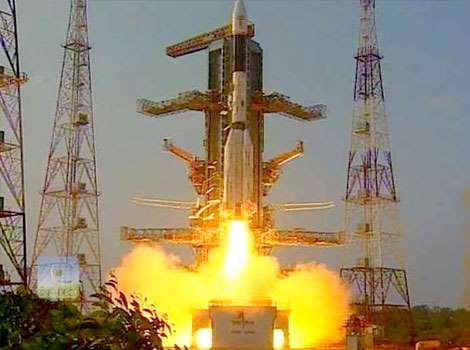August 27, 2015
Isro's large GSAT-6 communication satellite which has several strategic applications was on Thursday placed in orbit by a rocket powered by a home-made cryogenic engine.

ISRO: GSLV-D6, an advanced communication satellite, was launched from the Second Launch Pad at Satish Dhawan Space Centre SHAR (SDSC SHAR), Sriharikota. (Image via Twitter, @isro)
August 27, 2015
Isro's large GSAT-6 communication satellite which has several strategic applications was on Thursday placed in orbit by a rocket powered by a home-made cryogenic engine.

ISRO: GSLV-D6, an advanced communication satellite, was launched from the Second Launch Pad at Satish Dhawan Space Centre SHAR (SDSC SHAR), Sriharikota. (Image via Twitter, @isro)
The Geostationary Satellite Launch Vehicle (GSLV-D6) rocket lifted off from Sriharikota spaceport at 4.52pm on Thursday carrying the satellite. This was the ninth flight of the GSLV and the third development flight using a cryogenic engine.
Just after the lift-off the second stage was ignited successfully, followed by the crucial third stage of cryogenics. After some time the GSLV-D6 with indigenous cryo engine successfully placed GSAT-6 in orbit.
Isro chairman Kiran Kumar told Hindustan Times: "One of the advanced features of GSAT 6 satellite is its S Band unfurlable antenna of 6m diameter. This is the largest satellite antenna made by our space agency. The antenna will be utilized for five spot beams over the Indian main land.
GSAT-6 is the twenty fifth geostationary communication satellite of India built by ISRO and twelfth in the GSAT series. Five of GSAT-6's predecessors were launched by GSLV in 2001, 2003, 2004, 2007 and 2014 respectively.
GSAT-6 satellite provides communication through five spot beams in S-band and a national beam in C-band for strategic users. The cuboid shaped GSAT-6 has a lift-off mass of 2117 kg. Of this, propellants weigh 1132 kg and the dry mass of the satellite is 985 kg.
The other advanced feature of the satellite is the 70 V bus, which is flying first time in an Indian communication satellite. After its injection into a geostationary transfer orbit by GSLV-D6, ISRO's Master Control Facility (MCF) at Hassan will take control of GSAT-6 and perform the initial orbit raising maneuvers by repeatedly firing the Liquid Apogee Motor (LAM) on-board the satellite,
This will finally place the satellite in the circular geostationary orbit. After this, the deployment of the antenna and three axis stabilization of the satellite will be performed and GSAT-6 will be positioned at 83 deg East longitude.
Courtesy: HT







































































































